main: November 2007 Archives
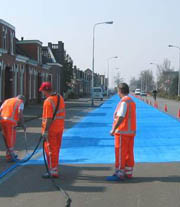
From the Trontoist and Wooster Collective Text from Trontoist. Images from Artist.
Last April, 2007 Henk Hofstra created an "urban river" in Drachten, The Netherlands. The Blue Road installation is an example of what mind-blowing urban public art can be.
Featuring 1000 metres of road painted blue and the phrase "Water is Life" written in eight-metre-high letters across it, the Blue Road is reminiscent of the waterway that used to be where the road is now. It's a memorial to nature, but it's also just plain awe-inspiring. There's even a few cool tidbits along the road, like a sinking car.
The project took 4000 litres of paint and cost 75,000 Euros. Half of the cost was covered by municipal funds. Hofstra wants the road to be visible on Google Earth, but it hasn't shown up yet.
Weiss Comment
Very simple and low cost urbanistic gesture to reinforce the street as a space and a place. Compare not to million dollar streetscape projects with trees, benches, pavers and signage, but with 1000 meters (1/2 mile) lightpole banners and kiosks. Don't complain that its does not last, but focus on the memory like a Christo project. Remember when the street was blue.....
Hofstra paints everything blue and "cars in the canal" is a little too easy and contradicts the canal metaphor, but makes provides for some populist photographic opportunities.
In our green universe, we start to analyze by life cycle costing. I wonder how many years the street could be painted blue before the exceeding the cost of permanent pavers? My experience in Florida is that the "permanent" streetscapes are redone every 20 years. Some cities in Florida use colored pink concrete sidewalks. But the cities that paint the sidewalks rather than stain have a much better solution for image, color and cleanliness.
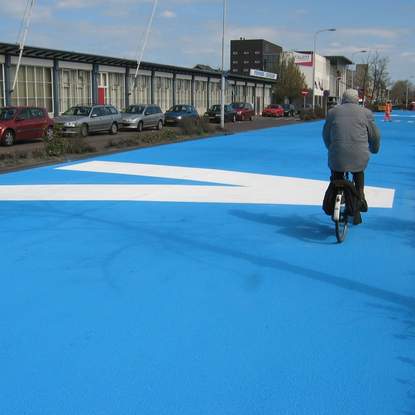
Blue Road by Henk Hofstra, April 2007
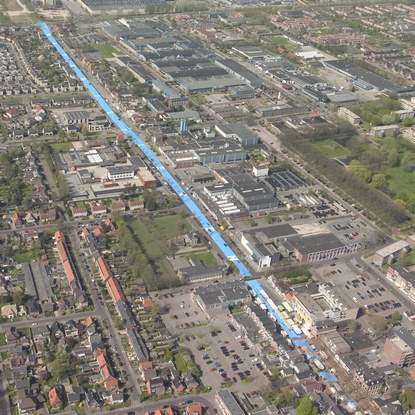
Drachten, The Netherlands
Digg it...Del.icio.us ...Technorati...Stumble Upon..Reddit
Submit by November 19, 2007, photographer Orrin has sponsored a public art photography competition on the Flickr site "Theme Competition/Discuss". Flickr has a very simple system for the competition. Each person easily "tags" his/her photograph with a competition specific code. Great way to link up images on the net. The leftside photo is one image "tagged" by Damiel from a cinema in Prague.
As on November 16, thirty-six photos had been posted. As I have written before, the ability of a public artworks to attract the photographer is a significant criteria of success. As I look at the photographs, I believe the photographers value the following.
1. Something temporary caught by the camera. Either the artwork itself will disappear or something is temporarily interacting with the artwork such as people or light.
2. Contrasting scale. Oversized or undersized on the street.
3. Juxtaposition of almost anything. Style of art and site. Connotations of art and people.
4. Ability to photograph from strange angles, but up to the sky is most popular
5. Dynamic motion of the image in the photograph (not necessarily at the site)
6. Color in the drab city. Either the art or the blue sky
7. Looks like a well composed tourist brochure photograph.
8. Just plain strange. Can you believe this exists?
After checking out the photos, I visited artist Leslie Fry's website. I know she once dated a very talented photographer. He had taken or influenced some of the images on her site.
2007 Temporary Installation in Florida. Studio in Vermont.
Florida: Temporary. Just plain strange.
Vermont: Composed tourist brochure.
Park in Vermont. Installation in New York.
Vermont: Strange angle - shooting up. Capturing evening light.
New York: Oversized object. Contrasting room and object. Capturing a moment of light.
Public Art for Broward County Libraries in Florida.
These projects are not succeeding photographically as public art. The photographer may document this type of art as an object that he/she may like, but the artwork in its setting does not motivate the photographic mind.
Digg it...Del.icio.us ...Technorati...Stumble Upon..Reddit
Thanks to Joey at Curbed, check the info on the construction barrades in Lower Manhattan. Joey photographed one barricade in process and spotted the NYTime story.
The project is documented with complete photographs on how to construct this street elements at reconstructionnyc.org. Re:construction is organized by Alliance for Downtown NY in collaboration with the Lower Manhattan Cultural Council.
I am attracted to the project due to its internal contradictions of being both
1. invisible - visible (normal barricade - public art event) and
2. legible symbol - confusing metaphor ( simple safety alert - artistic message)
As result, the orange zebra barricade is most successful.
Zebra concrete barricade by Tattfoo Tan Photo: NY Times.
Striped fences by Carlos J. Gómez de Llarena, Mateo Pintó and Carolina Cisneros
Design of overhead barricade by Richard Garber and Nicole Robertson of GRO Architects
On the street construction by GRO. Reported by Joey on Curbed.com
Of course, the construction barricade or safety fence has been the material of other artists. Unfortunately I can not find the images of Lo Tec's fence in 2001 in Fort Lauderdale. Carolyn Law's overlapped vinyl chainlink in the early 1980s for an electrical substation fence in Seattle. She continues work in chainlink today.
Broad Street Station in Seattle by Carolyn Law in early 1980s
Bridge Fences in Kent, Washington by Carolyn Law in 2006
Digg it...Del.icio.us ...Technorati...Stumble Upon..Reddit
Over at artblog, writer Andrea Kirsh took the opportunity to dump on Philly's public art as an introduction to her review of two new books about public art in New York City. As Public Art Network gathers in Philly next June, here is my response to her.
Ms. Kirsh. Your assessment of the public art in Philly fails to grasp Public Art in its cultural and artistic role. Your critique is fine for readers in the artculture. From that perspective, you might be generally correct. But the artculture is generally limited in its abilities to assess public art as it is lazy. Local cultural investigation is just too much work, so remain with artculture values. I too in my blog at Artsjournal.com fail to sufficiently investigate.
As to Philly, first you need to provide links to www.philart.net with Chris Purdom's massive documentation of public art in Philly. And the mural database developed at UPenn is outstanding at cml.upenn.edu/murals.
Second: Many artworks in Philly dramatically outclass anything in NYC for their visual impact and cultural relationships. The scale of the giant murals of American African figures in distressed neighborhoods may be some of the most powerful public art works in the world. I know they stopped me in my tracks.
Tim Spencer by Cliff Hudson and Dr. J by Kent Twitchell
Herman Wrice by David McShane & Eurhi Jones and Malcolm X by James Burns & Ernel Martinez
The mosaic work of Isaiah Zagar covering thousands of square feet of buildings south of downtown Philly entertained me for an hour - a long time to appreciate public art. Lily Yeh's Village in Germantown with its memorials and murals should have international stature for its integration of community building and artistic excellence.
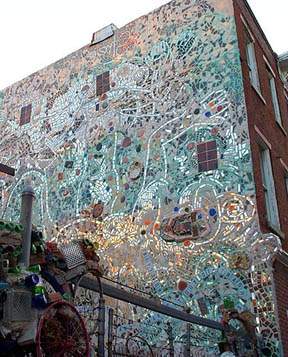
Isaiah Zagar. Photo by Mosaic Art Source
Lily Yeh's Village of Arts and Humanities
Philly's fifteen or more Ben Franklin public artworks is pleasantly insane. James Peniston installed the lastest in October, 2007. The Rocky sculpture at the museum strikes hard at the relationship between art, popular movies and picture taking - an important cultural relationship.
I continue to strive for intellectual and artistic excellence in public art, but with additional critical values added to important ones of artculture
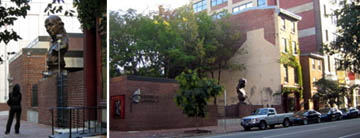
James Peniston's Keys To Community
Digg it...Del.icio.us ...Technorati...Stumble Upon..Reddit
For artists, designers, architects and city planners, global warming is not a complete disaster. Suddenly the bureaucracies and politicians are willing to consider new directions in built forms. An explosion of actual possibility.
Global warming has two responses. 1. New carbonless energy sources will be harnessed to human use and the Chinese and Indians can join the middle class consumer culture. 2. All human action must be coordinated with the natural environment to slow the process of warming the planet and 90% of humans will experience new inconveniences. The first one is like the lottery. If it happens, good news for the planet and humans. But better assume not and plan for the second.
So far from the designers, we have seen the integration of planet savings devices and operation into appliances, buildings and a tiny bit of city planning. Both the high designer and eco-village builders depend on a technological assessment. High design focuses on reduced energy consumption and a perkier work or home indoor environment. Eco-village seeks a broader reduction in the use of all types of new material and celebrates the "machine" of natural processes that results in a perkier outdoor environment. High design seeks changes without lifestyle changes or much daily thought. Eco-village is an alternative lifestyle that links family-like community values with love for nature.
Two contemporary artist-designer-architects have found artistic expression of a new relationship between humans and natural processes. They move in opposite directions to find poetic integration, rather than either symbols of nature surrounding humans or delicate human acts within nature. The artists intentional blur the classic line between nature and human, but they are separate enough to caress or battle each other. Culturally and realistically, humans cannot jump to some medieval sci-fi, animated nature-man fusion (despite all the movies). While the human race changes its values, human and nature will stand apart.
Architecture and Nature: Opposite ways of integation by Singer and del Sol
In Michael Singer's universe, nature invades the human world. Nature is a force that demands respect. Singer's stones are placed as though the actions of erosion and plants have already modified the human construction. His instincts recall the great illustrations of ancient construction partial consumed by nature. These are named "ruins" - the human thing made dysfunctional by Nature.
Nature never retreats: Piranesi's 1750 Rome and Catherwood's 1840 Mexico
Singer's cut-stone await nature: La Jolla view, Michigan levee and Denver garden
But plants are not Nature. Singer uses the plants like machines to oxygenate the air, clean the water, attract animals and enhance the human psyche. The architecture is protected from the actions of the roots and clasping vines. Rain is controlled and/or water supplied. In his larger projects, facility bi-products "feed" some other facility or action in ways that imitate natural processes.
Singer's nature invades architecture: Labortory in Netherlands and Airport in Denver
In his best work such as the Denver Airport, nature's dirt, her messiness and her decay symbolically threaten the illusion of man's perfection of milled steel and glass. Not just mental symbols, but tactile contrast of wet and dry. Singer uses nature in the other direction as a symbol and producer of healthiness as in NYC Greenpoint powerplant. The greenhouse walls give a vision of overall of health and safety to the industrial activity within.
Singer's New York Powerplant and Catherwood's Pyramid
Art and design compete in Singer's work. By art, I mean an intellectual and emotional jarring that Singer provides with contrast and the power of nature in the human world. By design, I mean a synthesis of functional needs and visual forms where the best solutions are comfortable. Singer's desire to contribute to multi-disciplinary collaboration and to motivate people to do the right thing environmentally has led him to many comfortable works that are better evaluated by engineers and activists, than public art critics.
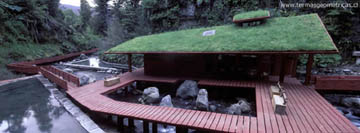
Del Sol's Termas Geomeatas
German del Sol from Santiago, Chile, is a designer and architect that has built three eco-hotels in extreme regions of ice and desert. In reverse of Singer, del Sol intervenes into almost mythic Nature with human constructions. The work responds to human excesses of dominating the Earth by demonstrating ways to follow nature or flow with it - and still be human. Never dissolving into nature. Always celebrating raw nature through a gentle contrast of color or texture or long edges. The forms separate the earth from sky, steaming water from forest canopy, inside from out and human path from untouched nature. Both the separation and thing separating co-exist equal. In the time of saving the planet, humans can still be humans and nature, nature.
Christo's Running Fence and Robert Smithson's Asphalt Flow have similar requests, although the artists may have started form different purposes. Running Fence brings the curves of the landscape to life by following edges of the land through the human thing of fabric and line. Smithson pours the toxic human manufactured product down the gullies of the naturally abused canyon. Contrasting with the color of the hill and contrasting with the speed of water, the asphalt hugs the land and intensives its shapes and scares. The artistic effect of the repeated human action of dumping is one of assault and beauty. It questions and celebrates the human actions on the earth that are being performed for non-artistic reasons without a care.
Christo and Robert Smithson: Human action follows the land
Del Sol limits his sentences of making to path and fence interacting with raw nature through the animation of sunlight (harsh, luminous or wet). Paths mark the place for humans in nature while fences isolate sections of land and sky. But nothing is pure as the fences are broken and marks of nature dot the sections of land. Humans need not be pure in their relationship with nature. Neither do humans need to exaggerate through a rational contrast. The two remain separate fully influenced and engaged by the other.
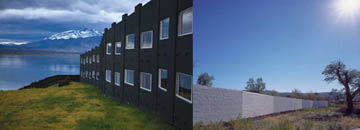
Del Sol's gentle break between ground and sky: Patagonia Ice and Atacama Desert
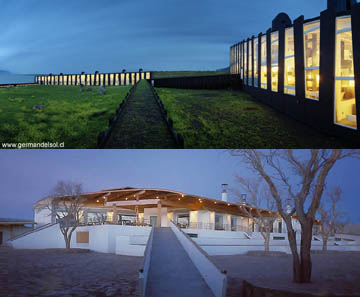
Del Sol's captured nature: Patagonia stone and Atacama trees
In their art, both Singer and del Sol express a truth of engagement with nature. Singer brings nature to urbanity and del Sol marks nature with humanness. In this time of environmental crisis, both demonstrate a respect for nature that understands that she has the power to stand and survive. For at the end of it all, humans will die, not nature.
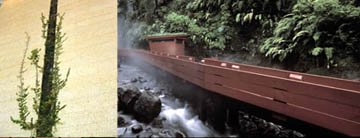
Nature and Architecture: Opposite slices by Singer and del Sol
.
Excellent Sculpture Magazine Interview with Singer.
Del Sol's Spanish Poetry and Images
Del Sol's photos by Guy Wemborne
.
.
.
I like these images, but could not find a place from them above.
Del Sol's plans: Capture with ways to run away
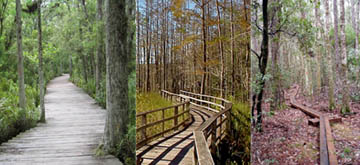
Florida Boardwalks: Fragile human access to nature
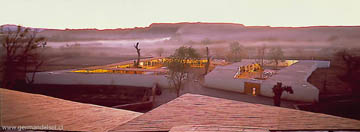
Del Sol touching lightly in the Atacama desert
Digg it...Del.icio.us ...Technorati...Stumble Upon..Reddit
Blogroll
AJ Ads
AJ Blogs
AJBlogCentral | rssculture
Terry Teachout on the arts in New York City
Andrew Taylor on the business of arts & culture
rock culture approximately
Laura Collins-Hughes on arts, culture and coverage
Richard Kessler on arts education
Douglas McLennan's blog
Dalouge Smith advocates for the Arts
Art from the American Outback
For immediate release: the arts are marketable
No genre is the new genre
David Jays on theatre and dance
Paul Levy measures the Angles
Judith H. Dobrzynski on Culture
John Rockwell on the arts
Jan Herman - arts, media & culture with 'tude
dance
Apollinaire Scherr talks about dance
Tobi Tobias on dance et al...
jazz
Howard Mandel's freelance Urban Improvisation
Focus on New Orleans. Jazz and Other Sounds
Doug Ramsey on Jazz and other matters...
media
Jeff Weinstein's Cultural Mixology
Martha Bayles on Film...
classical music
Fresh ideas on building arts communities
Greg Sandow performs a book-in-progress
Exploring Orchestras w/ Henry Fogel
Harvey Sachs on music, and various digressions
Bruce Brubaker on all things Piano
Kyle Gann on music after the fact
Greg Sandow on the future of Classical Music
Norman Lebrecht on Shifting Sound Worlds
publishing
Jerome Weeks on Books
Scott McLemee on books, ideas & trash-culture ephemera
theatre
Wendy Rosenfield: covering drama, onstage and off
Chloe Veltman on how culture will save the world
visual
Public Art, Public Space
Regina Hackett takes her Art To Go
John Perreault's art diary
Lee Rosenbaum's Cultural Commentary
Tyler Green's modern & contemporary art blog
